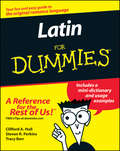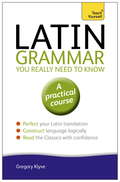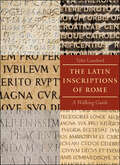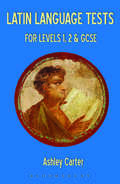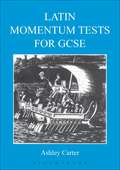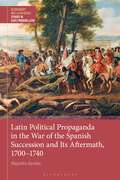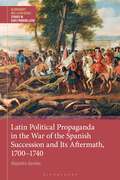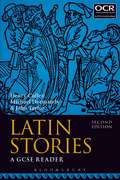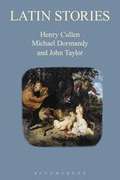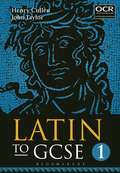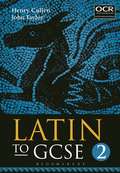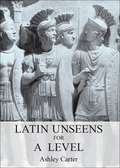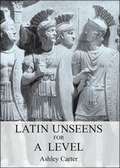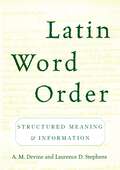- Table View
- List View
Latin For Dummies
by Clifford A. Hull Steven R. PerkinsMaster the basics of a lyrical and useful language Even though most people don’t use Latin anymore, it used to be spoken by millions of people from across the ancient world. It later morphed into new languages we still use today! In Latin For Dummies, you’ll take a tour through the language of ancient Rome. Beginning with Latin you may already know, like “carpe diem” and “quid pro quo,” the book walks you through essential Latin grammar and everyday Latin phrases. It also explores how Latin shaped and molded modern languages, including English. In this book, you’ll find: Lessons to learn Latin grammar and vocabulary Practices for reading, translating, and composing Latin Tips to recognize commonly confused Latin words Latin For Dummies proves that learning Latin, while challenging, can be fun and exciting too! It’s perfect for first timers interested in the ancient language and anyone who wants to learn more about ancient Roman history and culture.
Latin For Dummies (For Dummies)
by Clifford A. Hull Steven R. Perkins Tracy BarrEarn-lay atin-Lay? No, not that kind of Latin! You can learn trueLatin, with conjugations, declensions, and all those extrasyllables - and it's easier than you think.In fact, most people mistakenly think of learning Latin as perhapsthe most useless, tedious, and difficult thing to do on earth. Theycouldn't be more wrong. Latin For Dummies takes you back for a quick jauntthrough the parlance of ancient Rome, as well as discussing theprogress of Latin into church language, and its status today as the"dead" language that lives on in English, Spanish,Italian, and most other Western tongues. Written for those withzero prior knowledge of Latin, this snappy guide puts the basics atyour fingertips and steers clear of the arcane, schoolmarmstereotype of endless declensions and Herculean translations.Easy-to-understand sections describe: * Latin you already know * Grammar * Pronunciation * Latin in action * Latin in law * Latin in medicine * Latin for impressing your friends * And much more No dusty tome or other such artifact, Latin For Dummiesmakes learning fun and brings the language to life by presentingconversations in various Roman settings, as well as providing funfacts and stories about classical life. And if you feel you mayactually have a negative aptitude for the language, don'tworry; pronunciations and translations follow every expression, anda helpful mini-dictionary graces the book's last pages.You'll also find out about: * The quotable Roman * Latin graffiti * Latin authors who's who * Gladiator Latin * Latin in love, marriage, and family * From the mouth of Julius Caesar * Romans on drink * Helpful Latin-related Web sites * Fun and games exercises Designed to introduce and familiarize you with the languagerather than make you the next Cicero, Latin For Dummiesgives you all the tools you need to work at your own pace to learnas much or as little as you like. So noli timere (no-leetih-may-reh) - "have nofear" - and carpe diem ("pick upLatin For Dummies today")!
Latin Grammar You Really Need to Know: Teach Yourself (Teach Yourself Language Reference)
by Dr Gregory KlyveComprehensive and clear explanations of key grammar patterns and structures are reinforced and contextualized through authentic materials. You will not only learn how to construct grammar correctly, but when and where to use it so you sound natural and appropriate. Latin Grammar You Really Need to Know will help you gain the intuition you need to become a confident communicator in your new language.
Latin Grammarians on the Latin Accent: The Transformation of Greek Grammatical Thought
by Philomen ProbertLatin Grammarians on the Latin Accent offers a fresh perspective on a long-standing debate about the value of Latin grammarians writing about the Latin accent: should the information they give us be taken seriously, or should much of it be dismissed as copied mindlessly from Greek sources? This book focusses on understanding the Latin grammarians on their own terms: what they actually say about accents, and what they mean by it. Careful examination of Greek and Latin grammatical texts leads to a better understanding of the workings of Greek grammatical theory on prosody, and of its interpretation in the Latin grammatical tradition. It emerges that Latin grammarians took over from Greek grammarians a system of grammatical description that operated on two levels: an abstract level that we are not supposed to be able to hear, and the concrete level of audible speech. The two levels are linked by a system of rules. Some points of Greek thought on prosody were taken over onto the abstract level and not intended as statements about the actual sound of Latin, while other points were so intended. While this book largely sets aside the question whether the Latin grammarians tell us the truth about the Latin accent, focussing instead on understanding what they actually say, it begins to offer answers for those wishing to know when to 'believe' Latin grammarians in the traditional sense: the book shows which of their statements are intended - and which are not intended - as statements about the actual sound of Latin.
Latin Grammarians on the Latin Accent: The Transformation of Greek Grammatical Thought
by Philomen ProbertLatin Grammarians on the Latin Accent offers a fresh perspective on a long-standing debate about the value of Latin grammarians writing about the Latin accent: should the information they give us be taken seriously, or should much of it be dismissed as copied mindlessly from Greek sources? This book focusses on understanding the Latin grammarians on their own terms: what they actually say about accents, and what they mean by it. Careful examination of Greek and Latin grammatical texts leads to a better understanding of the workings of Greek grammatical theory on prosody, and of its interpretation in the Latin grammatical tradition. It emerges that Latin grammarians took over from Greek grammarians a system of grammatical description that operated on two levels: an abstract level that we are not supposed to be able to hear, and the concrete level of audible speech. The two levels are linked by a system of rules. Some points of Greek thought on prosody were taken over onto the abstract level and not intended as statements about the actual sound of Latin, while other points were so intended. While this book largely sets aside the question whether the Latin grammarians tell us the truth about the Latin accent, focussing instead on understanding what they actually say, it begins to offer answers for those wishing to know when to 'believe' Latin grammarians in the traditional sense: the book shows which of their statements are intended - and which are not intended - as statements about the actual sound of Latin.
The Latin Inscriptions of Rome: A Walking Guide
by Tyler LansfordRome’s oldest known Latin inscription dates from the sixth century BC; the most recent major specimen was mounted in 2006—a span of more than two and a half millennia. Remarkably, many of these inscriptions are still to be found in situ, on the walls, gates, temples, obelisks, bridges, fountains, and churches of the city. Classicist Tyler Lansford has collected some 400 of these inscriptions and arranged them—with English translations—into fifteen walking tours that trace the physical and historical contours of the city. Each itinerary is prefaced by an in-depth introduction that provides a survey of the history and topography of the relevant area of the city. The Latin texts appear on the left-hand page with English translations on the right. The original texts are equipped with full linguistic annotation, and the translations are supplemented with historical and cultural notes that explain who mounted them and why.This unique guide will prove a fascinating and illuminating companion for both sophisticated visitors to the Eternal City and armchair travelers seeking a novel perspective into Rome's rich history.
Latin Language Tests for Levels 1 and 2 and GCSE
by Ashley CarterThis collection of tests provides practice for students preparing to take the new Latin language examinations at the WJEC examination board Levels 1 and 2. It also includes tests similar to those used in the OCR examination board GCSE examinations. The book is divided into five sections, each devoted to a different format or level of tests. Words that are not expected to be known at each level are glossed. The range of grammatical and syntactical features is similar to that found in the public examinations. The tests are designed to cover translation and comprehension of specially constructed stories in Latin. Readers are not expected to have familiarity with any particular course book, and the stories may also be used simply as a graduated Latin reader, if desired.Also available from Bloomsbury: Latin Language Tests, by Mark Schemes 9781853997525
Latin Language Tests for Levels 1 and 2 and GCSE
by Ashley CarterThis collection of tests provides practice for students preparing to take the new Latin language examinations at the WJEC examination board Levels 1 and 2. It also includes tests similar to those used in the OCR examination board GCSE examinations. The book is divided into five sections, each devoted to a different format or level of tests. Words that are not expected to be known at each level are glossed. The range of grammatical and syntactical features is similar to that found in the public examinations. The tests are designed to cover translation and comprehension of specially constructed stories in Latin. Readers are not expected to have familiarity with any particular course book, and the stories may also be used simply as a graduated Latin reader, if desired.Also available from Bloomsbury: Latin Language Tests, by Mark Schemes 9781853997525
Latin Momentum Tests for GCSE
by Ashley CarterThis collection of 15 tests is modelled on those used in GCSE examinations. The first few are at the standard of Foundation Tier and provide appropriate practice for Foundation Tier candidates as well as an easier introduction to the harder tests for Higher Tier candidates. The remaining tests are designed for Higher Tier candidates. All the tests contain a range of grammatical and syntactical features appropriate for GCSE and assume a basic knowledge of about 500 words of vocabulary; other words and proper names are glossed. Each test consists of three sections: a passage of about 60 words, tested by simple comprehension questions; a passage of about 100 words, for translation; and a passage of about 90 words, tested by more demanding questions. A gradient of difficulty is maintained throughout the Latin. Each test also has two mark schemes, suitable for use by the teacher or by the student for self-assessment.
Latin Momentum Tests for GCSE
by Ashley CarterThis collection of 15 tests is modelled on those used in GCSE examinations. The first few are at the standard of Foundation Tier and provide appropriate practice for Foundation Tier candidates as well as an easier introduction to the harder tests for Higher Tier candidates. The remaining tests are designed for Higher Tier candidates. All the tests contain a range of grammatical and syntactical features appropriate for GCSE and assume a basic knowledge of about 500 words of vocabulary; other words and proper names are glossed. Each test consists of three sections: a passage of about 60 words, tested by simple comprehension questions; a passage of about 100 words, for translation; and a passage of about 90 words, tested by more demanding questions. A gradient of difficulty is maintained throughout the Latin. Each test also has two mark schemes, suitable for use by the teacher or by the student for self-assessment.
Latin Political Propaganda in the War of the Spanish Succession and Its Aftermath, 1700-1740 (Bloomsbury Neo-Latin Series: Studies in Early Modern Latin)
by Dr Alejandro CoroleuLatin Political Propaganda offers the first comprehensive study of the central role played by the Latin language to celebrate or undermine political power during the War of the Spanish Succession (1701-1715). Waged as much on the printed page as on the battlefield, this worldwide conflict gave rise to an astonishing variety of Latin writing across the Continent - in verse or in prose - on both the pro-Habsburg and pro-Bourbon sides. Ranging from official documents, epic, satirical and panegyric poetry to defamatory pamphlets, letters, historiographical and juridical tracts, medals and ephemeral architecture, this vast textual corpus has gone almost unnoticed. Alejandro Coroleu provides close examination of the literary devices of these texts and shows how imitation of models and figures from classical antiquity was at the heart of the authors' highly refined verse and prose technique. He also pays attention to the historical and social context in which the texts emerged, and connects the Latin political writing produced at the time with more popular forms of propagandistic discourse (literary or visual) which found its expression in the vernacular. This book also reveals how the learned language continued to function - even after the hostilities had come to an end in July 1715 - as an instrument of political discourse and propaganda on both sides of the dynastic feud up until the death of Emperor Charles VI in October 1740.
Latin Political Propaganda in the War of the Spanish Succession and Its Aftermath, 1700-1740 (Bloomsbury Neo-Latin Series: Studies in Early Modern Latin)
by Dr Alejandro CoroleuLatin Political Propaganda offers the first comprehensive study of the central role played by the Latin language to celebrate or undermine political power during the War of the Spanish Succession (1701-1715). Waged as much on the printed page as on the battlefield, this worldwide conflict gave rise to an astonishing variety of Latin writing across the Continent - in verse or in prose - on both the pro-Habsburg and pro-Bourbon sides. Ranging from official documents, epic, satirical and panegyric poetry to defamatory pamphlets, letters, historiographical and juridical tracts, medals and ephemeral architecture, this vast textual corpus has gone almost unnoticed. Alejandro Coroleu provides close examination of the literary devices of these texts and shows how imitation of models and figures from classical antiquity was at the heart of the authors' highly refined verse and prose technique. He also pays attention to the historical and social context in which the texts emerged, and connects the Latin political writing produced at the time with more popular forms of propagandistic discourse (literary or visual) which found its expression in the vernacular. This book also reveals how the learned language continued to function - even after the hostilities had come to an end in July 1715 - as an instrument of political discourse and propaganda on both sides of the dynastic feud up until the death of Emperor Charles VI in October 1740.
Latin Prose Composition: A Guide from GCSE to A Level and Beyond
by Andrew LeighThis book helps students to write Latin using increasingly complex forms of expression. Part 1 gives guidance and practice exercises for the new sentences required at GCSE, while Parts 2 and 3 contain a series of chapters of grammatical introduction and exercises for translation into Latin leading up to A Level and Pre-U. Part 4 takes students into more advanced areas of composition. Continuous passages are included from an early stage alongside stand-alone sentences. Leigh gives clear guidance on the characteristic features of Latin prose, such as word order and subordination, as well as more advanced grammatical complexities. At the back of the book, lists of vocabulary and accidence provide reference and revision tools for students at all levels.Working through the book the rewards of learning to write Latin are clear: not merely a challenge to be overcome, prose composition gives a heightened appreciation of how Latin authors used the language to express themselves in their own particular styles.
Latin Prose Composition: A Guide from GCSE to A Level and Beyond
by Andrew LeighThis book helps students to write Latin using increasingly complex forms of expression. Part 1 gives guidance and practice exercises for the new sentences required at GCSE, while Parts 2 and 3 contain a series of chapters of grammatical introduction and exercises for translation into Latin leading up to A Level and Pre-U. Part 4 takes students into more advanced areas of composition. Continuous passages are included from an early stage alongside stand-alone sentences. Leigh gives clear guidance on the characteristic features of Latin prose, such as word order and subordination, as well as more advanced grammatical complexities. At the back of the book, lists of vocabulary and accidence provide reference and revision tools for students at all levels.Working through the book the rewards of learning to write Latin are clear: not merely a challenge to be overcome, prose composition gives a heightened appreciation of how Latin authors used the language to express themselves in their own particular styles.
Latin Stories: A GCSE Reader
by Henry Cullen Michael Dormandy John TaylorLatin Stories is an ideal first reader for students of Latin. It offers 100 self-contained passages of manageable length, chosen for their intrinsic interest and adapted from a wide range of ancient authors. Generous help is given, with a short introduction to each story and glossing of all proper names and non-GCSE vocabulary. The collection will also be attractive to older students beginning or returning to the language. Updated to match the 2016 OCR specification, this edition has been restructured to reflect the new examinations, which now have a single language paper. Section 1 provides 30 passages, starting with very short and simple stories and building up to the level of the current OCR GCSE. Section 2 provides 30 differentiated passages of increasing difficulty on historical and miscellaneous topics. Section 3 provides 20 shorter passages of uniform length on mythological topics, with comprehension questions, in the style of Section A of the new GCSE language paper. Section 4 provides 20 passages on historical topics, with comprehension and unseen sections, in the style of Section B of the new GCSE language paper. The new edition is supported by a companion website with an answer key and additional passages.
Latin Stories: A GCSE Reader
by Henry Cullen Michael Dormandy John TaylorLatin Stories is an ideal first reader for students of Latin. It offers 100 self-contained passages of manageable length, chosen for their intrinsic interest and adapted from a wide range of ancient authors. Generous help is given, with a short introduction to each story and glossing of all proper names and non-GCSE vocabulary. The collection will also be attractive to older students beginning or returning to the language. Updated to match the 2016 OCR specification, this edition has been restructured to reflect the new examinations, which now have a single language paper. Section 1 provides 30 passages, starting with very short and simple stories and building up to the level of the current OCR GCSE. Section 2 provides 30 differentiated passages of increasing difficulty on historical and miscellaneous topics. Section 3 provides 20 shorter passages of uniform length on mythological topics, with comprehension questions, in the style of Section A of the new GCSE language paper. Section 4 provides 20 passages on historical topics, with comprehension and unseen sections, in the style of Section B of the new GCSE language paper. The new edition is supported by a companion website with an answer key and additional passages.
Latin Stories: A GCSE Reader (PDF)
by John Taylor Henry Cullen Michael DormandyLatin Stories is an ideal first reader for students of Latin. It offers 100 self-contained passages of manageable length, chosen for their intrinsic interest and adapted from a wide range of ancient authors. Generous help is given, with a short introduction to each story and glossing of all proper names and non-GCSE vocabulary. The collection will also be attractive to older students beginning or returning to the language. Section 1 provides 30 passages, starting with very short and simple stories and building up to the level of the current OCR GCSE paper Language 1. Section 2 provides 30 passages at the level of the GCSE paper Language 2, with its more demanding grammar and vocabulary requirements. Section 3 provides 40 longer passages in the style of current GCSE papers, with comprehension questions as well as sections for translation: 20 for Language 1 (stories from mythology or Roman life) and 20 for Language 2 (stories from Greek and Roman history).
Latin to GCSE Part 1
by Henry Cullen John TaylorA companion to Bloomsbury's popular two-volume Greek to GCSE, this is the first course for Latin students that directly reflects the curriculum in a clear, concise and accessible way. Enhanced by colour artwork and text features, the books support the new OCR specification for Latin (first teaching 2016) as well as meeting the needs of later students, both at university and beyond.Written by two experienced school teachers, one also an examiner, the course is based on a keen understanding of what pupils find difficult, concentrating on the essentials and on the explanation of principles in both accidence and syntax: minor irregularities are postponed and subordinated so that the need for rote learning is reduced. User-friendly, it also gives pupils a firm foundation for further study. Part 1 covers the basics and is self-contained, with its own reference section. It outlines the main declensions, a range of active tenses and a vocabulary of 275 Latin words to be learned. Pupil confidence is built up by constant consolidation of the material covered. After the preliminaries, each chapter concentrates on stories with one source or subject: the Fall of Troy, the journeys of Aeneas, the founding of Rome and the early kings, providing an excellent introduction to Roman culture alongside the language study.
Latin to GCSE Part 1
by Henry Cullen John TaylorA companion to Bloomsbury's popular two-volume Greek to GCSE, this is the first course for Latin students that directly reflects the curriculum in a clear, concise and accessible way. Enhanced by colour artwork and text features, the books support the new OCR specification for Latin (first teaching 2016) as well as meeting the needs of later students, both at university and beyond.Written by two experienced school teachers, one also an examiner, the course is based on a keen understanding of what pupils find difficult, concentrating on the essentials and on the explanation of principles in both accidence and syntax: minor irregularities are postponed and subordinated so that the need for rote learning is reduced. User-friendly, it also gives pupils a firm foundation for further study. Part 1 covers the basics and is self-contained, with its own reference section. It outlines the main declensions, a range of active tenses and a vocabulary of 275 Latin words to be learned. Pupil confidence is built up by constant consolidation of the material covered. After the preliminaries, each chapter concentrates on stories with one source or subject: the Fall of Troy, the journeys of Aeneas, the founding of Rome and the early kings, providing an excellent introduction to Roman culture alongside the language study.
Latin to GCSE Part 2
by Henry Cullen John TaylorA companion to Bloomsbury's popular two-volume Greek to GCSE, this is the first course for Latin students that directly reflects the curriculum in a clear, concise and accessible way. Enhanced by colour artwork and text features, the books support the new OCR specification for Latin (first teaching 2016) as well as meeting the needs of later students, both at university and beyond.Written by two experienced school teachers, one also an examiner, the course is based on a keen understanding of what pupils find difficult, concentrating on the essentials and on the explanation of principles in both accidence and syntax: minor irregularities are postponed and subordinated so that the need for rote learning is reduced. User-friendly, it also gives pupils a firm foundation for further study. Part 1 covers the basics, whilst Part 2 introduces a wider range of grammatical forms and constructions, with a vocabulary of 450 words and reading material about the developing Republic, the war with Hannibal, the rise of Julius Caesar, and Augustus and the early emperors. Practice passages and revision sentences for GCSE complete Part 2, which has a reference section covering the whole course.
Latin to GCSE Part 2
by Henry Cullen John TaylorA companion to Bloomsbury's popular two-volume Greek to GCSE, this is the first course for Latin students that directly reflects the curriculum in a clear, concise and accessible way. Enhanced by colour artwork and text features, the books support the new OCR specification for Latin (first teaching 2016) as well as meeting the needs of later students, both at university and beyond.Written by two experienced school teachers, one also an examiner, the course is based on a keen understanding of what pupils find difficult, concentrating on the essentials and on the explanation of principles in both accidence and syntax: minor irregularities are postponed and subordinated so that the need for rote learning is reduced. User-friendly, it also gives pupils a firm foundation for further study. Part 1 covers the basics, whilst Part 2 introduces a wider range of grammatical forms and constructions, with a vocabulary of 450 words and reading material about the developing Republic, the war with Hannibal, the rise of Julius Caesar, and Augustus and the early emperors. Practice passages and revision sentences for GCSE complete Part 2, which has a reference section covering the whole course.
Latin Unseens for A Level
by Ashley CarterThis collection of Latin unseen passages forms a companion volume to Latin Momentum Tests for GCSE, and is intended to be used similarly by students preparing for examinations at AS, A2 and AEA levels. The largest section is set at AS level and comprises prose passages forming a coherent story based on original sources but simplified to maintain a level of difficulty appropriate for this level. The text assumes the student will have a working knowledge of a typical vocabulary list of about 1000 words. Most of the rest of the passages are, with rare exceptions, un-adapted Latin, both prose and verse, taken from the authors used in the examinations. Difficult or rare words are glossed. The last few passages are of a standard of difficulty appropriate to AEA level. All passages are of a similar length and format to those used in the examinations. One sample mark scheme has been included to give teachers and students some insight into how these unseens are marked in the examinations.
Latin Unseens for A Level
by Ashley CarterThis collection of Latin unseen passages forms a companion volume to Latin Momentum Tests for GCSE, and is intended to be used similarly by students preparing for examinations at AS, A2 and AEA levels. The largest section is set at AS level and comprises prose passages forming a coherent story based on original sources but simplified to maintain a level of difficulty appropriate for this level. The text assumes the student will have a working knowledge of a typical vocabulary list of about 1000 words. Most of the rest of the passages are, with rare exceptions, un-adapted Latin, both prose and verse, taken from the authors used in the examinations. Difficult or rare words are glossed. The last few passages are of a standard of difficulty appropriate to AEA level. All passages are of a similar length and format to those used in the examinations. One sample mark scheme has been included to give teachers and students some insight into how these unseens are marked in the examinations.
Latin Unseens For A Level (PDF)
by Ashley CarterThis collection of Latin unseen passages forms a companion volume to Latin Momentum Tests for GCSE, and is intended to be used similarly by students preparing for examinations at AS, A2 and AEA levels. The largest section is set at AS level and comprises prose passages forming a coherent story based on original sources but simplified to maintain a level of difficulty appropriate for this level. A knowledge of a typical vocabulary list of about 1000 words is assumed. Most of the rest of the passages are, with rare exceptions, unadapted Latin, both prose and verse, taken from the authors used in the examinations. Difficult or rare words are glossed. The last few passages are of a standard of difficulty appropriate to AEA level. All passages are of a similar length and format to those used in the examinations. One sample mark scheme has been included to give teachers and students some insight into how these unseens are marked in the examinations.

